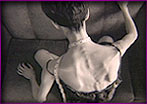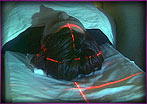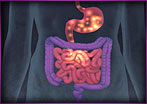|
|
Chapter 1:
Abnormally Thin
This chapter:
reveals that eating disorders are common in the world of dance. describes case studies of two women battling anorexia nervosa. describes the toll anorexia can take on the body including low blood
pressure, damage to the kidneys and liver, and heart failure. notes that anorexia has increased by 36 percent every five years since
the 1950s—at least 8 million people suffer from it—and the most
vulnerable age group is 15-24 year old women.
|
|

Watch the video in:
QuickTime |
RealVideo
Running time: 07:12
|
|
|
Chapter 2:
Cultural Pressures
This chapter:
reveals some reasons women develop eating disorders. recounts how the thin look became glamorous with 1960s model Twiggy. introduces
Joan
Jacobs Brumberg, author of "Fasting Girls," and her ideas concerning society's
idealization of thinness. profiles a plus-size model and her struggles with weight, anorexia, and
the modeling industry's expectations concerning thinness. reports historical accounts of food refusal and reasons for it.
|
|

Watch the video in:
QuickTime |
RealVideo
Running time: 07:36
|
|
|
Chapter 3:
The Search for Answers
This chapter:
states that three out of every 100 women develop anorexia or bulimia. suggests why some people may develop an eating disorder. describes common personality traits of people with eating disorders. notes that serotonin plays a role in mood and appetite and reports on
animal and human studies of brain serotonin levels and their relationship to
diet and starvation.
|
|

Watch the video in:
QuickTime |
RealVideo
Running time: 04:17
|
|
|
Chapter 4:
Treatment
This chapter:
states that anorexia is one of the most difficult psychiatric illnesses
to treat. conveys the importance of addressing the underlying causes that led to
the disorder as well as the related symptoms and behaviors. discusses the experiences and feelings of some people with anorexia. describes typical personality traits of anorexics.
|
|

Watch the video in:
QuickTime |
RealVideo
Running time: 04:12
|
|
|
Chapter 5:
The Ballet World
This chapter:
profiles a 21-year-old ballerina and her struggles with both anorexia and
a self-inflicting cutting behavior. tells that for many dancers, there is a tendency to diet because one of
the only things they feel they can control is how much and what they eat. states that eating disorders are more common in women than men, but men
are still afflicted. notes that dancers are at particular risk for developing osteoporosis as
a consequence of anorexia.
|
|

Watch the video in:
QuickTime |
RealVideo
Running time: 08:31
|
|
|
Chapter 6:
Running On Empty
This chapter:
explains that strenuous exercise leads to a form of anorexia where
appetite is healthy but exercise is out of control. states that anxiety can be an underlying symptom of exercise anorexia. profiles a woman with this form of anorexia whose heart rate plummeted
after she worked out after running a marathon. cites a possible reason why Prozac is often not initially helpful for
anorexics.
|
|

Watch the video in:
QuickTime |
RealVideo
Running time: 06:20
|
|
|
Chapter 7:
Bulimia Nervosa
This chapter:
explains that the disorder bulimia nervosa, involving binge eating and
purging, often begins when girls are 18 years old and at a normal weight. notes that Prozac, psychotherapy, and cognitive behavior therapy often
are helpful treatments for bulimia. explains that one aspect of bulimia relates to disturbances in feeling
satisfied with a meal—the body chemical CCK contributes to sensations of
fullness, but for bulimics, less CCK is released, and they continue to eat. reports on a study regarding how food is processed in active and
recovering bulimics.
|
|

Watch the video in:
QuickTime |
RealVideo
Running time: 07:07
|
|
|
Chapter 8:
Road to Recovery
This chapter:
|
|

Watch the video in:
QuickTime |
RealVideo
Running time: 06:10
|
|